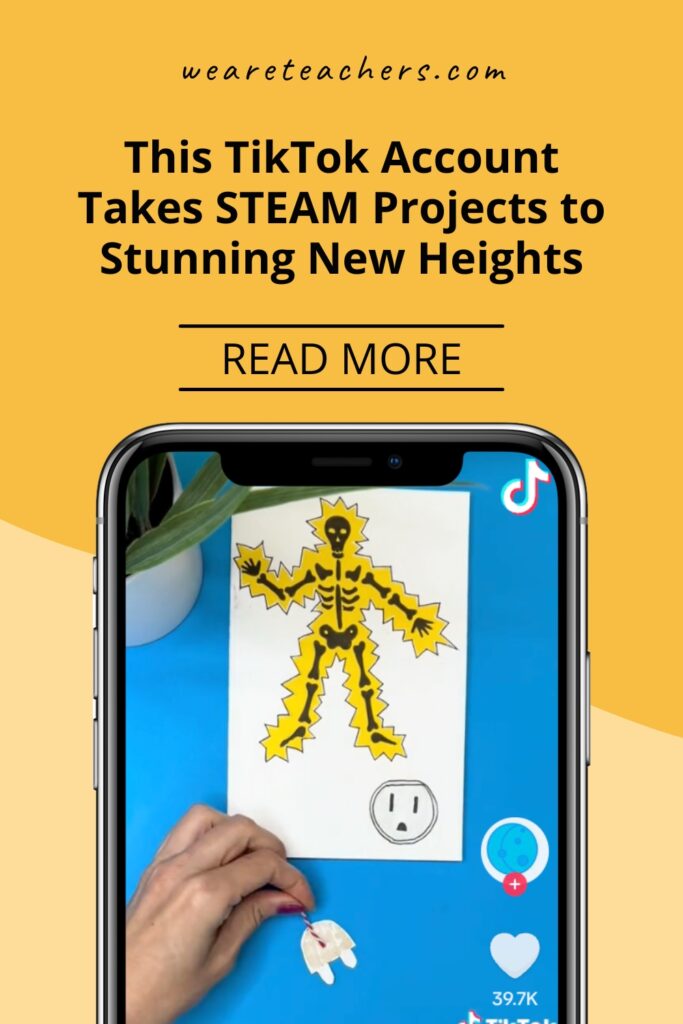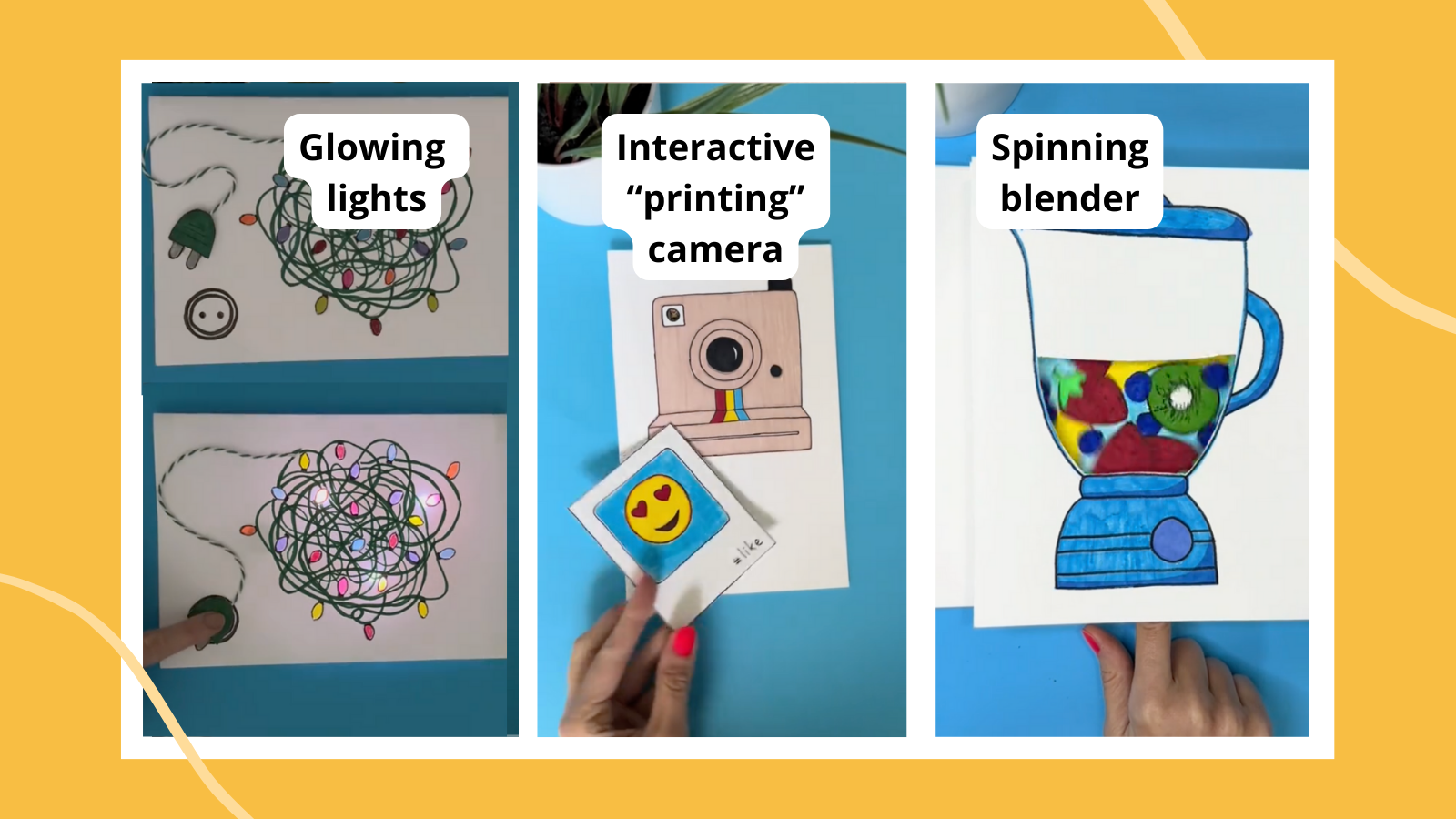If you teach middle or elementary school science and you’re not already following @moonshotkidz on TikTok or Instagram, this is your sign to do so. @moonshotkidz shares easy and fun science, technology, and art projects, with the goal of inspiring their viewers to get creative. Their STEAM projects highlight simple circuitry, motors, and coding, perfect for meeting some of your elementary NGSS standards. Not to mention, the finished products are stunning.
While the science is relatively simple, the results are anything but. So, how can you use these videos to jump-start your next STEAM lesson plan? I’ll share my science teacher–approved ideas!
3 Ways To Use @Moonshotkidz in Your Science Class
1. Spark interest in a phenomenon
My first thought as I scrolled through the @moonshotkidz Instagram account was “Wow, how did they do that?”
Students will likely have the same reaction to the eye-catching projects. But don’t be too quick to give them the answers! Instead, leverage this excitement as an opportunity to get them experimenting.
Teachers in the 20 states that have adopted the Next Generation Science Standards will recognize the term “phenomenon-based instruction.” NGSS resources define phenomena as “observable events that occur in the universe and that we can use our science knowledge to explain or predict.” The goal of a phenomenon is to shift a lesson or unit from “learning about a topic to figuring out how or why something happens.” For a phenomenon to be effective, it must be engaging to students. They need to be excited about what they’re observing and invested in figuring out how it’s possible. Enter @moonshotkidz!
To utilize a @moonshotkidz project as a phenomenon, show students the final product, then present them with the materials they would need to re-create it on their own and let them try it out! Through trial and error, students can construct a simple circuit that produces light by correctly connecting wires, a battery, and a bulb. This one is perfect for Valentine’s Day:
However, completing the circuit doesn’t have to be the end of the learning. Students will have tons of questions about why some combinations worked while others were unsuccessful. Their experimentation can become the basis for generating questions (through a QFT or other method) to launch your NGSS-aligned unit on energy transfer. The circuitry-based videos are a wonderful launch for 4th grade teachers covering NGSS standards 4-PS3-2 and 4-PS3-4.
2. Embrace STEAM in a new and authentic way
Content-focused middle school science teachers already scrolling past this section, hear me out. The first time I heard about STEAM, I was wary. Even though I love art and consider myself a creative person, I didn’t think engaging students in art would have a meaningful impact on learning in my science classroom. I’d seen too many science lessons that attempted to incorporate an artistic or creative aspect only to have students regurgitate facts onto unoriginal, albeit visually pleasing, posters. And while I gave students opportunities to express themselves artistically, these extensions were always optional. The priority, I thought, needed to be the content. But as I explored @moonshotkidz, I started to consider this wasn’t always the case.
I began looking into STEAM instruction with a new lens. It turns out there was a lot more to it than I’d originally given it credit for. XQ, an educational institution dedicated to reimagining the high school experience, had a philosophy on STEAM that resonated with me. They share on their website that “the arts must be integrated into the lesson so students can see how each relevant discipline connects and works together. This allows students to develop and use skills naturally embedded in the arts and humanities, including empathy, creativity, and communication.”
The projects on @moonshotkidz truly integrate science with the arts. And there’s no glittery three-paneled science fair posters in sight! Let’s take a closer look at how these projects strike a delicate balance between rigorous scientific learning and art. We’ll also explore how you can collaborate with colleagues across your school to bring them to your students.
Many of the projects demonstrated by @moonshotkidz use small bursts of light or movement to enhance a piece of artwork. My personal favorites are this lighthouse:
And this jellyfish:
Both are impressive works in their own right, but only become more remarkable when illuminated or set in motion.
For art teachers, this is an opportunity to discuss the role that light or movement could play in a piece. It introduces questions about which pieces would be most enhanced by light or movement, and how this might change the way the artist communicates with their audience. After working to design and create an art piece, students could then use their STEM skills to add a light or movement component to their work. For a language arts component, students could write an artist’s statement explaining how the technology they’ve added contributes to their work. Taking a deep dive into the role technology takes in the finished piece creates a truly meaningful STEAM project.
3. Model another scientific concept
Recently, I attempted to teach my 7th graders about how neurons communicate messages from the body to the brain and back again, and how this process is disrupted as the result of concussive force to the brain. “It’s like wires!” I explained excitedly. “When you plug a light in, the signal can travel through the wire. When you unplug it, the signal can’t reach its destination!”
I’m sure the analogy resonated with a few of my students. But for the ones who need a more literal representation, the words on their own likely weren’t enough. Then, as I scrolled through @moonshotkidz later that same day, I saw my words come to life:
By connecting the wire to the battery, this video shows how a completed circuit allows a message to reach a receiver… just like the completed loop between the nerves, brain, and muscles I had described to my students.
Neuronal communication isn’t the only concept a circuit analogy can illustrate. In fact, it can be used to show how disrupting one step in a process can alter the entire outcome of a process driven by cause-and-effect relationships. Challenge yourself to rethink some of the analogies you use in your science classroom. Do you see any that could be improved with a @moonshotkidz visual?
Inspired yet?
If you’re ready to bring a @moonshotkidz project to your classroom, make sure to follow them on Instagram or TikTok. You can also become a supporter on Patreon to gain access to additional resources for a small fee per month. Your support will allow you to gain access to printable templates, project instructions, and video lessons. It’s worth suggesting to your admin to see if your district will sponsor adding these STEAM projects to your classroom Not to mention all of the profits from Patreon supporters go to materials and tools to create even more projects. So, what are you waiting for? Go forth and get creative with STEAM!
For more articles like this, be sure to subscribe to our newsletters.

